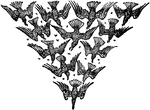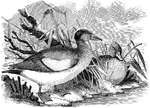
American Wigeon
"Mareca americana. American Wigeon. Bald-pate. Bill grayish-blue, with black tip and extreme base; feet…
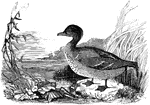
American Green-winged Teal
"Querquedula (N.) carolinensis. American Green-winged Teal. Bill black; feet bluish-gray: iris brown.…

Northern Shoveler
"Spatula clypeata. Shoveller Duck. Broad-bill. Bill blackish; iris orange-red: feet vermilion-red. Head…
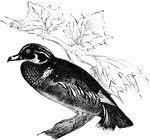
Wood Duck
"Aix sponsa. Wood Duck. Summer Duck. "The Bride." Adult Male: Bill pinkish-white, with lake-red base,…
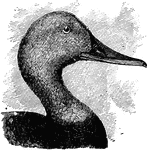
Canvas-back Head
"Fuligula vallisneria. Canvas-back. Adult male: The head close-feathered. Bill high at the base and…
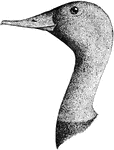
Large Canvas-backs Head
"Fuligula vallisneria. Canvas-back. Adult male: The head close-feathered. Bill high at the base and…
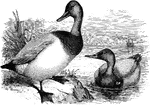
Canvas-backs
"Fuligula vallisneria. Canvas-back. Adult male: The head close-feathered. Bill high at the base and…

Small Redhead
"Fuligula ferina americana. Red-head. American Pochard. The feathers of the head somewhat full and puffy,…
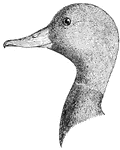
Large Redhead
"Fuligula ferina americana. Red-head. American Pochard. The feathers of the head somewhat full and puffy,…
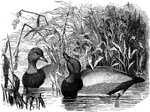
Redheads
"Fuligula ferina americana. Red-head. American Pochard. The feathers of the head somewhat full and puffy,…
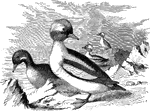
Buffleheads
"Clangula albeola. Buffle-head. Butter-ball. spirit-duck. Dipper. Bill with nostrils rather behind than…

Labrador Duck
"Camptolaemus labradorius. Labrador Duck. Pied Duck. Adult male: Bill black with orange at base and…

The Bill of an Eider
"Somateri mollissima. Somateri dresseri. Common Eider. Bill gibbous at base of upper mandible; outline…
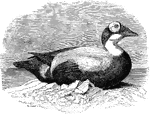
Spectacled Eider
"Somateria fischeri. Spectacled Eider. Bill (in both sexes) peculiar in the extension upon it of dense…
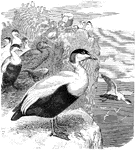
Eider Ducks
"Somateria mollissima. European Eider Duck. Bill with lateral frontal process extending on each side…

Black Scoter
"Oidemia americana. American Black Scoter. Sea Coot. Adult male: Plumage entirely black, less glossy…

Surf Duck
"Oidemia perspicillata. Surf Duck. Sea Coot. Adult male: Bill as above, singularly variegated in color,…

Trowbridge's Surf Duck
"Oidemia perspicillata trowbridgii. Trowbridge's Surf Duck, With the bill longer, exceeding the head,…
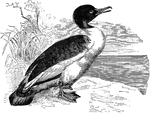
Merganser
"Mergus merganser. Merganser. Goosander. Nostrils near middle of bill. Frontal feathers extending acutely…

Red-breasted Merganser
"Mergus serrator. Red-breasted Merganser. Nostrils near base of bill. Frontal feathers extending obtusely…

The Bill of a North American White Pelican
"North American White Pelican. Bill several times as long as the head, comparatively slender, but strong,…
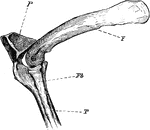
The Knee-joint of a Cormorant
"Phalacrocorax bicristatus. Cormorant. The knee-joint of a Cormorants. F, femur; P, patella; T, tibia;…

Red-faced Cormorant and Nest
"Phalacrocorax bicristatus. Red-Faced Cormorant. Frontal feathers not reaching base of the culmen, the…
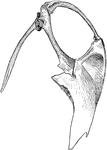
Cormorant Sternum and Shoulder
"Phalacrocorax bicristatus. Red-Faced Cormorant. Sternum and the shoulder from the skeleton of a Cormorant."…
Cormorant Skull
"Phalacrocorax bicristatus. Red-Faced Cormorant. Skull showing sto, occipital style or nuchal bone;…

Double-crested Cormorant
"Phalacrocorax dilophus. Double-crested Cormorant. Tail of 12 feathers. Gular sac convex behind. No…
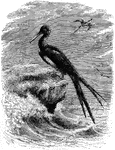
Frigate Birds
"Tachypetes aquilus. Frigate. Man-of-War Bird. brownish-black, glossed with green of purplish, duller…
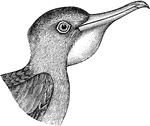
Frigatebird Head
"Tachypetes aquilus. Frigate. Man-of-War Bird. brownish-black, glossed with green of purplish, duller…

White-headed Gull Head
"Larus heermanni. White-headed Gull. Bill shorter than head or tarsus, rather slender, moderately compressed,…

Laughing Gull Bill
"Chroicocephalus atricilla. Laughing Gull. Black-headed Gull. Bill longer than middle toe and claw,…

Roseate Tern
"Sterna dougalli. Roseate Tern. Paradise Tern. Bill about as long as head or foot, straight, slender,…
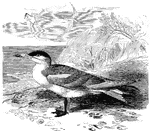
Caspian Tern
"Sterna (T.) caspia. Caspian Tern. Imperial Tern. Bill dark vermilion red, growing and somewhat "diaphanous"…

Royal Tern
"Sterna (T.) maxima. Cayenne Tern. Royal Tern. Adult in summer: Pileum glossy greenish-black, not extending…
Elegant Tern
"Sterna (T.) elegans. Elegant Tern. Princely Tern. Bill bright red, salmon-colored toward tip. Feet…

Sandwich Tern
"Sterna (T.) cantiaca. Sandwich Tern. Ducal Tern. Bill black, the tip 1/2 to 3/4 an inch bright yellow,…

Tail of Forster's Tern
"Sterna forsteri. Forster's Tern. Tail 5.00 - 8.00, forked 2.50-5.00." Elliot Coues, 1884

Aleutian Tern
"Sterna aleutica. Aleutian Tern. Bill of ordinary shape, as in hirundo, macrura, etc., entirely black.…

Sooty Tern Foot
"Sterna fuliginosa. Sooty Tern. feet stout; toes short; with much incised webs; tibia bare .70; tarsus…

The Foot of a Bridled Foot
"Sterna anaisthetikos. Bridled Tern. The foot of a Bridled Tern; Tarsus .85; middle toe the same, with…

The Bill of a Skimmer
'Rhynchops. Skimmer. Bill hypognathous Among the singular bills of birds that frequently excite our…
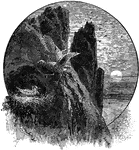
Fulmar and Nest
"Fulmarus. Fulmar. Adult: White; mantle pale pearly-blue, restricted to back and wings, or extending…
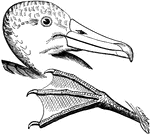
Bill and Foot of a Short-tailed Albatross
"Diomedea brachyura. Short-tailed Albatross. Bill 5.00 or 6.00 inches long, with long, with moderately…

Sooty Albatross
"Phoibetria fuliginosa. Sooty Albatross. Plumage ordinarily uniform sooty-brown; quills and tail blackish…

Slender-billed Fulmar
"Priocella tenuirostris. Slender-billed Fulmar. Adult: Plumage white, with clear pearly-blue mantle,…

Ripe Chick's Skull
"Ripe chick's skull, longitudinal section, vied inside, x 3 diameters; after parker. In the mandible…

Ripe Chick's Skull Profile
"Ripe chick's skull, longitudinal section, vied inside, x 3 diameters; after Parker. px, premaxillary;…

The Skull of a Woodpecker
"Side view of a woodpecker's skull, showing the long slender basihyal (bh), bearing slight elements…

Top View of a Woodpecker Skull
"Top view of skull of Cloaptes, (flickers) showing thyrohyals running along the skull and into right…
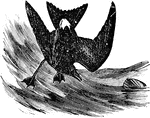
Leach's Petrel
"Cymochorea leucorrhoa. Leach's Petrel. White-rumped Petrel. Coloration as in the last species (pygmy…

Black Petrel
"Cymochorea melaena. Black Petrel. Form of the last very nearly; bill more robust; tarsus a little longer…

Black-vented Shearwater
"Puffinus opisthomelas. Black-vented Shearwater. Dark color of upper parts extending farther on sides…

Sooty Shearwater
"Puffinus fuliginosus. Sooty Shearwater. Nearly uniform dark sooty-brown, blackening on quills and tail-feathers,…
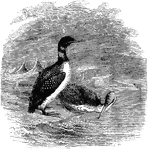
Loons
"Colymbus torquatus. Common Loon. Great Northern Diver. Adult: Bill black, the tip and cutting edges…

Common Loon
"Colymbus torquatus. Common Loon. Great Northern Diver. Adult: Bill black, the tip and cutting edges…
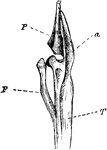
Leg Bones of a Grebe
"F. Fibula; T, tibia, with a, its cnemial process, and P, large patella, of a grebe." Elliot Coues,…
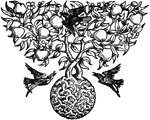
Fruit Tree
This is a fruit tree drawing, possibly and apple tree. Its roots are shown in the shape of a ball and…

Boy and Birds
Stories for children is a children's book by Francis Peard. This is one of the drawings in the book…

The Skull Structure of an Ostrich
"Dromaeognathous skull of ostrich, nat. size specimen no. 16,629, U.S. Nat Museum, by Dr. R. W. Shufeldt,…

The Skull of a Tinamou
"Dromaeognathous skull of a tinamou (Tinamus robustus); copies by Shufeldt from Huxley. Letters as before;…
